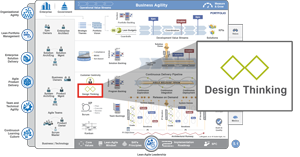« Design Thinking (SAFe) » : différence entre les versions
Page créée avec « Category: Agilité à grande échelle Catégorie:Portail Product Owner Category: SAFe Auteur : © 2010-2022 Scaled Agile, Inc.<br /> Source : [https://www.... » |
|||
| Ligne 18 : | Ligne 18 : | ||
__TOC__ | __TOC__ | ||
==Design Thinking== | ==Design Thinking== | ||
...<br/> | |||
==Description détaillée== | ==Description détaillée== | ||
Version du 27 septembre 2022 à 10:56
Auteur : © 2010-2022 Scaled Agile, Inc.
Source : Design Thinking
Date : 10/02/2021 (dernière mise à jour)
Traducteur : Fabrice Aimetti
Date : 27/09/2022
Traduction :

Un bon design est en fait beaucoup plus difficile à distinguer qu'un mauvais design, en partie parce que les bons designs répondent si bien à nos besoins que le design est invisible, nous servant sans attirer l'attention sur lui. Un mauvais design, en revanche, exprime ses insuffisances de manière criante et se fait très visible.
- Don Norman, The Design of Everyday Things
Design Thinking
...
Description détaillée
En savoir plus
[1] Empathy Map Canvas. https://medium.com/the-xplane-collection/updated-empathy-map-canvas-46df22df3c8a
[2] Cooper, Alan, Robert Reimann, David Cronin, and Christopher Noessel. About Face: The Essentials of Interaction Design 4th Edition. Wiley, 2014.
[3] Patton, Jeff, and Peter Economy. User Story Mapping: Discover the Whole Story, Build the Right Product 1st Edition. O’Reilly Media, 2014.
[4] Snyder, Carolyn. Paper Prototyping: The Fast and Easy Way to Design and Refine User Interfaces. Morgan Kaufmann, 2003.
[5] Gothelf, Jeff, and Josh Seiden. Lean UX: Designing Great Products with Agile Teams. O’Reilly Media, 2016.